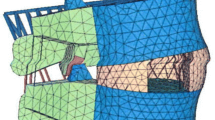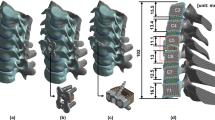Abstract
The authors present a new implant for vertebral body replacement in the thoracic and lumbar spine. Synex is a titanium implant designated for reconstruction of the anterior column in injury, post-traumatic kyphosis or tumour of the thoracolumbar spine and must be supplemented by a stabilizing implant. After positioning, the implant is distracted in situ, thus ensuring best contact with adjacent end-plates and three-dimensional (3D) stability, and minimizing the possibility of secondary dislocation or loss of correction. We compared the effectiveness of the Synex implant with that of the “Harms cage” (MOSS) in combination with two alternative stabilizing instrumentations: the USS and Ventrofix. In a 3D spinal loading simulator, we determined the bisegmental (T12–L2) neutral zone (NZ), elastic zone (EZ), and range of motion (ROM) of 12 human cadaveric spines. After corpectomy of L1, we tested the four possible combinations of stabilizing instrumentation and vertebral replacement implant: USS/Synex, USS/MOSS, Ventrofix/Synex, Ventrofix/MOSS. We analysed the differences between each of the instrumentations as well as differences compared to the intact spine. Comparing the two stabilizing implants, a significantly higher stability was achieved with the USS for flexion, extension, and lateral bending, regardless of whether Synex or MOSS was used as vertebral body replacement. No differences were observed for axial rotation. In addition, no implant combination was able to restore the rotational stability of the intact spine. Comparing the vertebral body replacing implants, significantly higher stability was noted with Synex in combination with USS for extension, lateral bending, and axial rotation. No differences between Synex and MOSS were observed in combination with Ventrofix. Posterior fixation was found to offer superior stability compared to anterior fixation. Synex was at least comparable to MOSS for suspensory replacement of the vertebral body in the thoracolumbar spine. The increased biomechanical stability demonstrated for Synex suggests that a more rigid construction would also be achieved in vivo. When using MOSS in combination with posterior stabilization, the induction of intervertebral compression via the posterior fixator is recommended. This surgical step was not necessary with Synex.
Similar content being viewed by others
Author information
Authors and Affiliations
Additional information
Received: 25 January 2000 Revised: 5 May 2000 Accepted: 22 May 2000
Rights and permissions
About this article
Cite this article
Knop, C., Lange, U., Bastian, L. et al. Three-dimensional motion analysis with Synex . E Spine J 9, 472–485 (2000). https://doi.org/10.1007/s005860000185
Issue Date:
DOI: https://doi.org/10.1007/s005860000185




